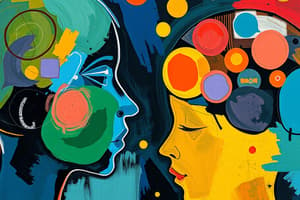Podcast
Questions and Answers
What is an indication of language ability in children?
What is an indication of language ability in children?
- Laughing
- Crying (correct)
- Walking
- Sleeping
What is the significance of day 1 in language development?
What is the significance of day 1 in language development?
- It is when a child starts schooling
- It indicates the beginning of language development (correct)
- It marks the onset of walking
- It is the day of birth
At what age do children typically start showing language ability?
At what age do children typically start showing language ability?
- At 10 years
- At 1 year
- At 5 years
- At birth (correct)
What is the primary purpose of crying in infants?
What is the primary purpose of crying in infants?
What does crying indicate in children?
What does crying indicate in children?
What is the primary focus of language development in Stage 1?
What is the primary focus of language development in Stage 1?
At what age do infants typically start babbling?
At what age do infants typically start babbling?
What is the main milestone achieved by the end of the first year?
What is the main milestone achieved by the end of the first year?
What type of sounds are primarily produced in Stage 1?
What type of sounds are primarily produced in Stage 1?
What is the key characteristic of infant language development during Stage 2?
What is the key characteristic of infant language development during Stage 2?
What is a characteristic of a child's language during Stage 5 of language development?
What is a characteristic of a child's language during Stage 5 of language development?
At what age do children typically possess the basic syntactic, semantic, phonological, and phonetic systems of their first language?
At what age do children typically possess the basic syntactic, semantic, phonological, and phonetic systems of their first language?
What is a feature of a child's language during Stage 6 of language development?
What is a feature of a child's language during Stage 6 of language development?
What is a limitation of a child's language during Stage 5 of language development?
What is a limitation of a child's language during Stage 5 of language development?
What is a characteristic of a child's language during Stage 8 of language development?
What is a characteristic of a child's language during Stage 8 of language development?
What is a feature of a child's language during Stage 5 of language development?
What is a feature of a child's language during Stage 5 of language development?
At what age do children typically start to develop more complex, adult-like conversational skills?
At what age do children typically start to develop more complex, adult-like conversational skills?
What is a characteristic of a child's language during Stage 7 of language development?
What is a characteristic of a child's language during Stage 7 of language development?
What is a characteristic of children's language development at Stage 3?
What is a characteristic of children's language development at Stage 3?
At what age do children typically experience a vocabulary explosion?
At what age do children typically experience a vocabulary explosion?
What is an example of overgeneralizations in children's language development?
What is an example of overgeneralizations in children's language development?
How many words do children typically have at Stage 3?
How many words do children typically have at Stage 3?
What is a characteristic of children's language development at Stage 4?
What is a characteristic of children's language development at Stage 4?
Study Notes
Language Development in Children
- Crying is the first form of language development in children, indicating their language ability.
Stage 1: 0-2 months
- Infants start cooing, producing vowel-like sounds, mainly "a" and "o" sounds (e.g., aaaaah, ooooooh).
Stage 2: 3-6 months
- Infants begin babbling, adding consonants to sounds, mainly using "a", "o", "e" vowels and "b", "m", "d", "t" consonants (e.g., maaaaaa, baaaaa, غاااااااا).
Stage 3: Beginning of 2nd year
- One-word utterances emerge, with a limited vocabulary of around 5 words (e.g., Ma, ba, da, bab bab bab).
- Infants develop a link between communication and sound-making signals, marking the onset of language.
Stage 4: 18 months olds
- A vocabulary explosion occurs, with children learning words at a faster rate (20-50 words).
- Overgeneralizations appear, where children use a single word to refer to multiple objects or people (e.g., baba for all men, mama for all women, dada for all children).
Stage 5: Just before end of 2nd year and beginning of 3rd year
- Two-word utterances emerge, combining two nouns or a noun and a verb (e.g., dad go, mamy milk, go sleep).
- Telegraphic speech develops, with an abbreviated language style similar to a telegram.
- Overgeneralizations continue, and children start to use functional words like "the" and "and".
- Inflections are rare, and vocabulary is limited to the child's immediate environment.
Stage 6: Third year to beginning of 4th year
- Complete utterances emerge, with some conversational skills.
- Children's vocabulary expands, and they develop metalinguistic awareness (e.g., recognizing "bad words").
- Their language skills become more advanced, with a focus on the here-and-now environment.
Stage 7: 5-6 years
- Children possess the basic syntactic, semantic, phonological, and phonetic systems of their first language (L1).
- They achieve adult-like fluency and mastery of L1 knowledge.
- Conversational skills become more advanced, similar to those of adults.
- Metalinguistic awareness deepens and widens.
Stage 8: 7-13 years
- Children develop more complex, adult-like conversational skills.
- Their grammar and knowledge of L1 become more advanced and complex.
- They continue to refine their language skills, achieving a more sophisticated level of communication.
Studying That Suits You
Use AI to generate personalized quizzes and flashcards to suit your learning preferences.
Related Documents
Description
Learn about the stages of language development in children, from day 1 and beyond. Understand the language abilities of infants and how they develop over time.




